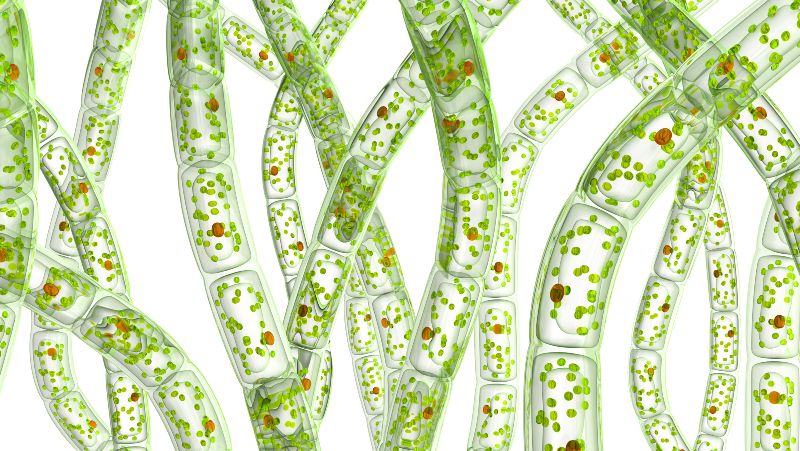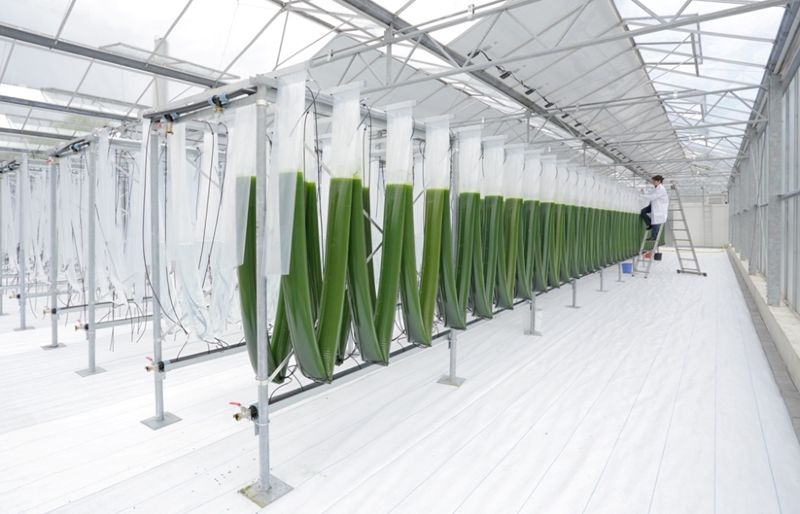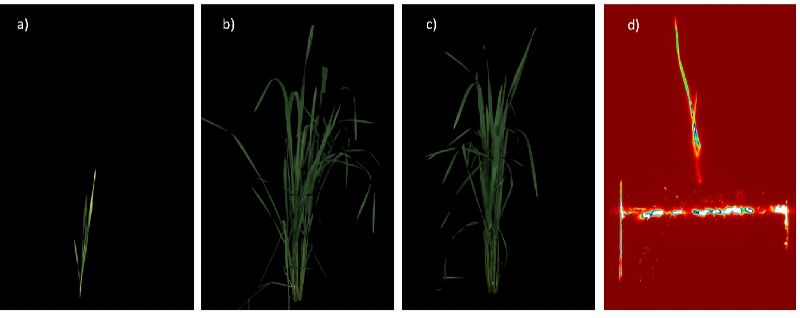
Our nutrient streams are inefficient and in some cases wasteful in terms of substance, energy, and water. Every opportunity to establish a real cycle should be seized to become more independent and future-oriented. Fast-growing and ingredient-rich microalgae are a promising and flexible resource of the future. Effective nutrient transfer back to the plant via microalgae fertilizer was shown in the AlgalFertilizer project.
In addition to light and water, plants also need nutrients, in particular a lot of phosphorus and nitrogen. Until now, large quantities of mineral fertilizer have been used. The phosphorus contained in these fertilizers is extracted from phosphorus-containing rocks that have formed over millions of years. Global deposits are limited and concentrated in a few high-yield locations. In view of independent food production, especially with regard to phosphorus, the most efficient resource recovery possible is an important investment in the future. Algae can play an important role here – they take up phosphorus very effectively from their environment and grow much faster than land plants under appropriate light conditions and by uptake of climate-damaging CO2. The AlgalFertilizer project with its five Core Groups in the BioSC has investigated the phosphorus uptake of microalgae from phosphate-containing water and wastewater and the transfer of this phosphorus from the microalgae biomass to wheat plants.

Good for the environment
Initially, the researchers were interested in how exactly the efficient phosphorus uptake in algae cells works. With this scientific understanding, they could identify especially effective algae species and implement further optimizations. Subsequently, they investigated whether these algae take up phosphorus completely from the water. In doing so, the algae could make an important contribution to water purification in treatment plants since the limit values for phosphorus in purified wastewater will be further lowered in the future – effective separation methods are therefore essential. At the same time, algae also take up nitrogen and both nutrients cause eutrophication, an overfertilization, in rivers and lakes if present in excess.
Another question is whether a plant can be adequately provided with the input of nutrient-rich algae biomass. The algae cells studied in the project contain the nutrients phosphorus and nitrogen in an optimal mixture for plant growth. Do these nutrients also reach the plant? Is an algae-based fertilizer even superior to a mineral fertilizer since the nutrients are released only gradually from the algae cells and thus can act more long-term as a kind of depot nutrient? To answer these questions, nutrients, water, algae, soil, and plants must be brought together experimentally to precisely monitor the nutrient transfer.
Successful tests
The algae were initially produced in a biomimetic bioreactor at Forschungszentrum Jülich. This produced cell densities more than twice as high due to especially effective light distribution. These algae were produced for the characterization of phosphorus uptake. For the significantly larger quantities of algae biomass needed for the field and pot experiments, the researchers produced the same algae in tubes in the greenhouse. One liter of algae solution usually yields only one to two grams of dried algae biomass. Thus, several cubic meters of algae solution must be cultivated for a sufficient quantity of fertilizer. Since this is carried out using sunlight in the greenhouse, this kind of production is less consistent than in the laboratory but reliably provides the required biomass.
Nutrient uptake from water showed that certain previously starved algae of the Chlorella species take up much more phosphorus than they need for their metabolism. This so-called luxury uptake accounts for up to eight percent of the dry mass while the phosphorus content is usually only one percent. To understand the underlying processes, the scientists analyzed the actual amount of phosphorus in the cells and the forms in which it is present. For example, the phosphorus can occur as free phosphate, as polyphosphate chains bound together or organically bound.
These forms affect plant availability of phosphorus after degradation of the algae biomass in the soil. It could be shown that the phosphorus accumulates in the cell in polyphosphate chains, a quickly available storage form. A complementary computer model from the Heinrich Heine University of the phosphorus metabolism simulates the growth of the algae with the data thus obtained. It describes the dynamic and the conversion between the different phosphorus forms in the cell. Conclusion: algae offer very good conditions to remove phosphorus from water or wastewater. Based on the results obtained, a promising algae fertilizer strategy can be developed.

Confirmed in nature
In an initial field experiment on previously normally fertilized soil, researchers of the University of Bonn compared the effect of algae, chicken dung, and mineral fertilizer on the germination and growth of wheat plants. The result: the plants grew unhindered in all three experimental designs. This was followed by automated pot experiments jointly designed by Forschungszentrum Jülich and the University of Bonn to compare the form of application: dry or fresh algal biomass and mineral fertilizer as a control in standard and shortage fertilization. Analyses of the growth and irrigation were carried out with a crane system equipped with a camera and enabled statistical evaluation. The wheat plants fertilized with algal biomass, dry as well as fresh algae fertilizer, were almost equivalent to the mineral fertilizer.
The question remained whether the phosphorus taken up by the plants actually comes from the algae or from microorganisms composting the algae or whether phosphorus already bound in the soil is dissolved again by these processes. Thus, the algae were supplied with radioactive 33phosphorus in a controlled laboratory experiment and used as fertilizer in so-called rhizotron experiments. The wheat plants fertilized in this way were characterized at different development stages using a bio-imager for the visualization of radioactivity.
It could be shown in roots and leaves that indeed the algal phosphorus was taken up by the plants – initially delayed compared to the mineralized phosphorus but to the same extent after approximately three weeks. The delayed availability suggests an upstream release mechanism and thus a longer bioavailable residence in the topsoil. Algal-borne phosphorus thus delays fast phosphorus binding to minerals such as transfer to the subsoil and minimizes the loss of the nutrient with regard to the use by plants.
With these results, AlgalFertilizer confirms the potential of algae in the nutrient cycle. Future projects should then allow bioeconomic evaluation and usage.
Project Coordinator
Prof. Dr. Oliver Ebenhöh
Institute of Quantitative and Theoretical Biology, HHU Düsseldorf
Email
Participating Core Groups
Prof. Dr. Oliver Ebenhöh
Institute of Quantitative and Theoretical Biology, HHU Düsseldorf
Prof. Dr. Ulrich Schurr, Dr. Christina Kuchendorf, Dr. Ladislav Nedbal
IBG-2 Plant Sciences, Forschungszentrum Jülich
Prof. Dr. Wulf Amelung
INRES – Soil Science and Soil Ecology, University of Bonn
Prof. Dr. Harry Vereecken, Dr. Diana Hofmann, Dr. Nina Siebers
IBG-3 Agrosphere, Forschungszentrum Jülich
Prof. Dr. Andreas Weber, Dr. Tabea Mettler-Altmann
Institute for Biochemistry of Plants, HHU Düsseldorf
Funding period
01.11.2015 - 31.10.2017
Funding
AlgalFertilizer is part of the NRW-Strategieprojekt BioSC and thus funded by the Ministry of Culture and Science of the German State of North Rhine-Westphalia.
Publications
Singh, D, Nedbal, L, and Ebenhöh, O (2017) Modelling phosphorus uptake in microalgae. Biochem Soc Trans 46(2): 483-490.
Schreiber, C, Schiedung, H, Harrison, L, Briese, C, Ackermann, B, Kant, J, Schrey, SD, Hofmann, D, Singh, D, Ebenhöh, O, Amelung, W, Schurr, U, Mettler-Altmann, T, Huber, G, Jablonowski, ND and Nedbal, L (2018). Evaluating potential of green alga Chlorella vulgaris to accumulate phosphorus and to fertilize nutrient-poor soil substrates for crop plants. Journal of Applied Phycology.
Moudříková, Š, Nedbal, L, Solovchenko, A and Mojzeš, P (2017). Raman microscopy shows that nitrogen-rich cellular inclusions in microalgae are microcrystalline guanine. Algal Research 23: 216-222.
Moudrikova, S, Sadowsky, A, Metzger, S, Nedbal, L, Mettler-Altmann, T and Mojzes, P (2017). Quantification of Polyphosphate in Microalgae by Raman Microscopy and by a Reference Enzymatic Assay. Anal Chem 89(22): 12006-12013.
Solovchenko, A, Verschoor, AM, Jablonowski, ND and Nedbal, L (2016). Phosphorus from wastewater to crops: An alternative path involving microalgae. Biotechnol Adv 34(5): 550-564.